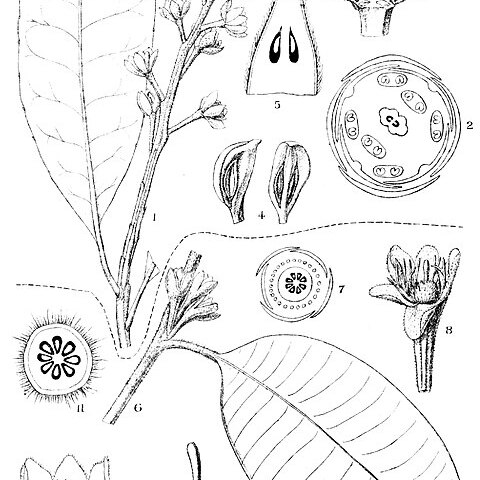Shrubs or small trees. Leaves simple coriaceous, exstipulate, almost entire to distinctly glandular-dentate, penninerved, scattered, subopposite to pseudo-whorled, articulate at base. Racemes terminal or axillary, bracteate at base, at most as long as the leaves. Floral bracts early caducous. Flowers bisexual, actinomorphic, the pedicel articulate at the base, all opening about simultaneously, white. Sepals 4, free, decussate, widely imbricate, mostly hooded, sometimes less convex, rounded, outer ones mostly ± saccate at base, and with prominent midrib. Petals free, 0 or 4 similar to the sepals but of more fleshy texture, all caducous at anthesis. Disk 0. Stamens 1-seriate, 4, 6, or 8-13, ± sessile, after being exposed appearing as a globular body, sometimes with a few (1-3) flimsy appressed persistent appendages added (? staminodes), at anthesis free and expanded; connective firm, brown outside; anther-cells introrse and lengthwise dehiscent. Ovary superior, sessile on a thickened receptacle, often with grooves from the pressure of the stamens in bud, ± fusiform or cylindric, capped by a fleshy, cap-shaped, sessile, slightly bisected stigma; cells 2, each with one pen-dent, apically attached, apotrophic ovule. Pseudo-drupe broad-ellipsoid to sub-globular, not rarely asymmetric, crowned by the stigma. Pericarp fleshy, finally black. Seed(s) 1 and having the shape of the fruit, or 2 and then plano-convex. Embryo small, surrounded by a thick, chalazal envelope, of which the outer layer is hard and bony and whether or not ruminate functioning as and superficially resembling the structure of a pyrene; this bony layer sometimes ridged outside and star-shaped in CS.
More
Leaves in pseudowhorls, opposite or (not in Australia) alternate, glandular-dentate, pinnately veined, exstipulate. Flowers in few-flowered terminal and subterminal racemes. Sepals 4–8, free. Petals absent or (not in Australia) sometimes 4–8. Stamens 6–10; filaments free, short or almost absent, thick, flattened; anthers with broad petaloid connective sometimes produced beyond locules. Ovary sessile, grooved, 2-locular; stigma large, sessile. Drupe with thick endocarp, usually 1-seeded.
Petals absent. Stamens 6 or 9-13. Sclerified outer tissue of the pachychalaza in mature fruit ruminated in its softer inner tissue. Leaves without a hypodermis and with a simple open vascular system. Anatomy different from species of sect. Sphenostemon.
Petals 4. Stamens 4 or 6. Sclerified outer tissue of the pachychalaza in fruit circular, not ruminated. Leaves with a hypodermis and closed vascular system in midrib.

